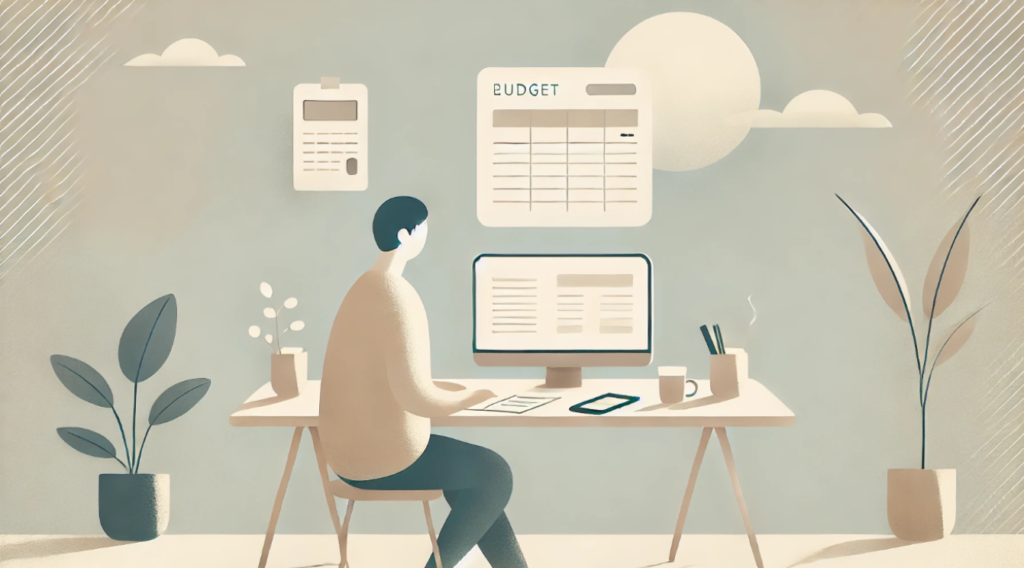
Present the idea that organizing your finances isn’t as difficult as it may seem and that the article will provide a simple, step-by-step blueprint.
Did you know that 78% of Americans live paycheck to paycheck, and 40% can’t cover a $400 emergency expense without borrowing money or using credit? It’s a common struggle to stay on top of our finances, but the impact of financial disorganization goes beyond just numbers in a bank account. It can lead to increased stress, poor budgeting, and a lack of savings, ultimately hindering our ability to achieve our future goals. But the good news is that organizing your finances doesn’t have to be overwhelming. By gaining financial clarity, you can reduce stress, improve budgeting, increase savings, and set stronger financial goals. This can ultimately lead to financial freedom and personal growth.
Assess Your Current Financial Situation
Track Your Income and Expenses:
It’s important to understand where your money is coming from and where it’s going because it helps you make informed financial decisions and stay on top of your financial goals. By tracking your income and expenses, you can identify areas where you may be overspending or where you can potentially save more money. There are various tools and methods available to help you track your income and expenses. Budgeting apps like Mint, YNAB, or Pocket Guard can automatically categorize your transactions and provide insights into your spending habits. Spreadsheets can also be a simple and effective way to track your income and expenses, allowing you to customize and organize your financial data according to your preferences.

Review Your Debts and Liabilities:
It’s important to review your debts and liabilities to have a clear understanding of your financial obligations. This includes knowing all outstanding debts, credit card balances, loans, and monthly obligations. Understanding the full scope of your financial liabilities can help you make informed decisions and create a realistic budget. It’s also crucial to pay attention to details such as interest rates, minimum payments, and due dates. Knowing the interest rates on your debts can help you prioritize which debts to pay off first. Understanding minimum payments and due dates can prevent late fees and potential damage to your credit score. Overall, reviewing your debts and liabilities is an essential step in taking control of your financial situation and working towards a more secure financial future.
Evaluate Your Assets :
It’s important to regularly evaluate your assets to get a clear understanding of your financial standing. This includes taking stock of your savings, investments, real estate, and any other valuable possessions you may have. By listing out these assets, you can get a better sense of your overall wealth. It’s also crucial to compare your assets to your liabilities, such as debts and financial obligations, to assess your net worth. This will give you a comprehensive view of your financial health and help you make informed decisions about your financial future. So, take some time to evaluate your assets and consider how they align with your overall financial goals.
Set Clear Financial Goals
Define Short-Term, Mid-Term, and Long-Term Goals:

Short-term goals are specific, achievable objectives that can be accomplished within a relatively short period, typically within a year or less. Mid-term goals are slightly more complex and may take a few years to achieve, such as saving for a down payment on a house or paying off a significant amount of debt. Long-term goals are more far-reaching and often require a longer time frame, such as saving for retirement or planning for a child’s college education. Breaking down financial goals into smaller, manageable parts can help to stay motivated and on track by providing a clear roadmap for success. By focusing on short-term goals, individuals can experience more frequent feelings of accomplishment, which can boost motivation and confidence.
Create SMART Goals:
SMART goals are a popular framework for setting and achieving objectives. The acronym stands for Specific, Measurable, Achievable, Relevant, and Time-bound. When setting a SMART goal, you want to ensure it is clear and specific, measurable so you can track progress, achievable within your abilities and resources, relevant to your overall objectives, and time-bound with a specific deadline for completion. For example, a specific and measurable goal could be to save $300 per month for a vacation fund. This goal is achievable if it fits within your budget and relevant to your desire for a future vacation. Setting a time-bound deadline, such as six months, makes it a SMART goal.
Build a Realistic Budget
Choose a Budgeting Method:

The 50/30/20 rule is a simple budgeting method that allocates 50% of income to necessities, 30% to discretionary spending, and 20% to savings and debt repayment. This method can work well for those who want an easy and flexible way to budget their finances. Zero-based budgeting involves assigning every dollar a specific purpose, whether it’s for expenses, savings, or debt repayment. This method is great for individuals who want to have a clear and detailed understanding of where their money is going and prioritize their spending accordingly. The envelope system is a cash-based budgeting method where you allocate funds for different spending categories and keep the cash in separate envelopes.
Allocate Money to Savings and Debt Repayment:
Budgeting for savings and debt repayment is crucial for long-term financial stability. While it’s important to cover day-to-day expenses, it’s equally important to prioritize saving for the future and paying off any outstanding debts. By creating a budget that includes regular contributions to savings and debt repayment, you can work towards achieving financial security. Having an emergency fund is essential, as unexpected expenses can arise at any time. By setting aside money in a dedicated emergency fund, you can avoid going into debt to cover these expenses and have peace of mind knowing that you have a financial safety net. Additionally, paying off high-interest debt should be a priority, as it can significantly impact your financial well-being.
Tools and Apps for Budgeting:
These budgeting apps and tools can be really helpful in managing your finances. Mint is great for tracking all of your expenses and income in one place, while YNAB helps you allocate your money to specific categories and prioritize your spending. If you prefer a more hands-on approach, a simple spreadsheet can also be effective for tracking your budget. Overall, these tools can make it easier to stay on top of your finances and reach your financial goals.
Set Up an Emergency Fund
Why You Need an Emergency Fund:
An emergency fund is a stash of money set aside to cover unforeseen expenses or financial emergencies. It is crucial for financial security because it acts as a safety net, providing a buffer against unexpected financial setbacks. Having an emergency fund can help you avoid going into debt when unexpected expenses arise, such as a medical emergency, car repairs, or a sudden job loss. By having money readily available, you can cover these expenses without having to rely on credit cards or loans, which can lead to long-term financial stress. Additionally, an emergency fund can provide peace of mind knowing that you have a financial cushion to fall back on in times of nice.
Where to Keep Your Emergency Fund:
It’s important to keep your emergency fund in a safe and easily accessible location. Some options for storing your emergency fund include high-yield savings accounts or money market accounts. These accounts offer the benefit of earning interest while still allowing you to quickly access your funds in case of an emergency. It’s important to choose a reputable financial institution and ensure that your funds are FDIC insured for added security.

Reduce and Manage Debt
List and Categorize Your Debts:
Sure, organizing debts by interest rate, balance, and payment terms can help prioritize which debts to pay off first. Start by making a list of all your debts, including credit cards, personal loans, student loans, and any other outstanding balances. Categorize each debt based on its interest rate, balance, and payment terms. Once you have categorized your debts, you can use a method such as the “debt avalanche” or “debt snowball” to prioritize which debts to pay off first. The debt avalanche method involves paying off the debt with the highest interest rate first, while the debt snowball method involves paying off the smallest balance first. Choose the method that works best for your financial situation.
Strategies for Debt Repayment:
The Debt Snowball method involves paying off your smallest debts first, regardless of interest rates, and then using the freed-up funds to tackle larger debts. This approach can provide a sense of accomplishment and motivation as you quickly eliminate smaller debts, which can help you stay on track with your repayment plan. On the other hand, the Debt Avalanche method focuses on paying off debts with the highest interest rates first, which can save you money in the long run by minimizing interest payments. However, this approach may take longer to see tangible results, as the largest debts may take longer to pay off. When choosing the right method for you, consider your financial goals, personality, and motivation.

Build Your Credit Score
Why a Good Credit Score Matters:
A good credit score matters because it can save you money on loans and open up more financial opportunities. Lenders use credit scores to determine the risk of lending to you, and a higher score can result in lower interest rates and better loan terms. For example, when applying for a mortgage or an auto loan, a good credit score can lead to lower interest rates, which can save you thousands of dollars over the life of the loan. Additionally, a good credit score can also affect insurance premiums, with some insurers offering lower rates to those with higher scores. Overall, maintaining a good credit score can lead to significant cost savings and better access to financial products and services.

Steps to Improve Your Credit Score:
Improving your credit score can seem daunting, but there are several steps you can take to make a positive impact. First, make sure to consistently pay your bills on time. Payment history accounts for a significant portion of your credit score, so staying current on all your accounts is crucial. Additionally, work on reducing your credit card balances. High credit card balances can negatively impact your credit utilization ratio, which is another important factor in your credit score. Aim to keep your credit card balances as low as possible and avoid carrying high levels of debt. Another important tip is to avoid applying for too much credit in a short period of time.
Start Saving and Investing
The Importance of Saving:
Saving is a crucial aspect of long-term financial security and wealth-building. By setting aside a portion of your income, you can create a safety net for unexpected expenses and work towards achieving your financial goals. Whether it’s saving for a vacation, a down payment on a home, or funding your child’s education, having a dedicated savings plan can help you reach these milestones. Furthermore, saving allows you to take advantage of investment opportunities that can help grow your wealth over time. By consistently contributing to a savings account or investment portfolio, you can harness the power of compound interest and potentially achieve financial independence in the future. Ultimately, saving is about preparing for the future and having the financial means to achieve your dreams and goals.
Basic Investment Strategies:
Investing is a great way to grow your wealth over time. There are several types of investments to consider, such as stocks, which represent ownership in a company; bonds, which are loans to a company or government; real estate, which involves buying property; mutual funds, which pool money from multiple investors to invest in a diversified portfolio; and retirement accounts like 401(k) and IRA, which offer tax advantages for saving for retirement. Starting early is key to maximizing the power of compounding returns, which means earning returns on your initial investment as well as on the returns themselves. This can significantly grow your wealth over time.

Stay Committed to Your Financial Journey
Remember to stay patient and persistent in your journey toward financial well-being. Organizing your finances is a continuous process, and small efforts can lead to lasting results. Keep assessing your finances, setting goals, budgeting, saving, managing debt, and investing. By staying committed to these steps, you can achieve financial clarity and growth. Keep up the good work!














